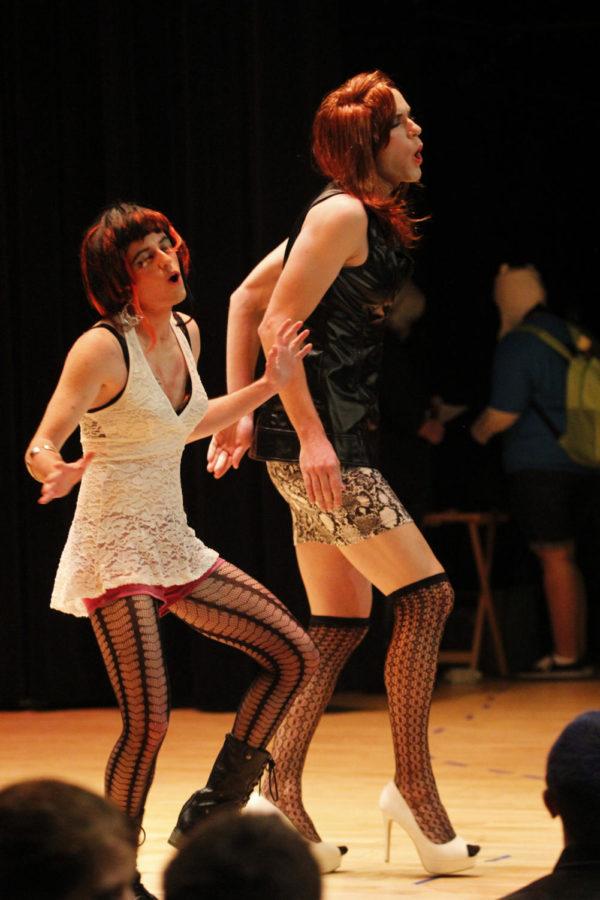Neuendorf: Skeptics should view drag as valid mode of expression, art
Jonathan Krueger/Iowa State Daily
As you may have mustered from the chalked rainbows pleasantly sprinkled throughout campus or the multitude of “Keep Calm and Pride On” shirt being displayed, it is pride week and the perfect ending to punctuate such a week is by a show that staunchly reaches for the definition of gender and twists it into unrecognizable fashion.
April 24, 2014
On April 26 in the Great Hall, a handful of men and women will be backstage preparing with makeup and get-ups that are abnormal for their day-to-day gender, and then they will march to the stage to perform — or should I say slay — a song or two.
Clearly, I am talking about drag.
As you may have mustered from the chalk rainbows pleasantly sprinkled throughout campus or the multitude of “Keep Calm and Pride On” shirts being displayed, it is Pride Week. The perfect ending to punctuate such a week is a show that staunchly reaches for the definition of gender and twists it into unrecognizable fashion.
I, too, proudly live in the bubble where drag is somehow ordinary, but it never loses its queer — pun totally intended — edge. Because of this, I am appalled when folks scoff at drag culture or when they wince at the idea of a drag queen or king who harnesses enough confidence to fill three football teams.
First off, a drag performer is a legitimate performer of a unique art that deserves the same recognition as a dancer, a singer, an actor, a designer or even a painter. I thought this was slowly but surely becoming the commonly held opinion, but I was snapped back to reality when I discovered I would not be able to use my attendance at the drag show for a review assignment for my introduction to performing arts class. The requirements of the assignment are to attend a show that displays one of the styles of performance we have covered in class: dance, music or theatre.
To my amazement, my professor does not believe drag is valid enough to claim any of these modes of expressions, which is untrue. Has she ever seen “Paris is Burning” or even five minutes of “RuPaul’s Drag Race?” Drag routines are choreographed to the detail and executed with precision. Though lip-synched, the choice of music is imperative to the success of the performance, and if the connection between performer and the music falls flat, then the show falls flat. But if the spark is there, then the show is divine not just for the star, but for the audience.
And if drag is anything, it is theatre on steroids. Everything from the makeup, the costuming, to the acting, sensibility is a hundred percent theatrics — it is more remarkable when you consider that the packaged performance is usually the result of one person’s hard work. Drag captures the essences of creativity and dedication and fuses them into a boundary-pushing declaration that may not be suitable for all.
Those hesitant to attend a show should only do so if they are too young for brazen sexuality — there is a flexible age limit to that — but if you are 18 or older, it is about time you at least sneaked a glimpse at the glittery underbelly of art.
I recently spoke with Cole Pippert, aged 19 aspiring and working drag queen from Cedar Falls, about his relationship with drag and his hopes for its future.
When asked whether or not he envisioned drag becoming more accessible he said, “I can see America warming up to the idea of drag queens with television shows. I think that most queens have very strong, dominant personalities, and that is what makes them so interesting to watch. I could definitely see a drag queen being the new Oprah.”
This may be the case, but the stigmas surrounding drag still exist and continue to be perpetuated, but Cole fascinatingly believes that a majority of the negative shades of these stereotypes originate within the LGBT community:
“I believe that stigmas come from within our own community. I have gone on several dates that have ended badly because of my drag career. There is a lot of stigma that all drag queens are loud, obnoxious and high maintenance. And I do believe that [most] stigmas come from other members of the LGBT community. I am no different than any other gay man or/and any other straight man for that matter. I have lazy days and I don’t always talk like I just popped out of a TLC music video, girl.”
But what is most admiring about the career is the person behind the persona: the dreams that are in tact, the seemingly un-quivering ambition and the lovable, just-out-of-reach personality. No other artist immerses in their art quite like a queen.
Pippert reveals that “Drag has become, and I speak for most queens when I say this, an outlet. It has become a place where I can be whatever I want, and whomever I want. I think that is why we get so sucked into it. Because it is an oasis away from our regular lives.”
All things considered, you have no reason not to attend the Drag Show at 7 p.m.Saturday in the Great Hall. Don’t be a drag; be a queen.







